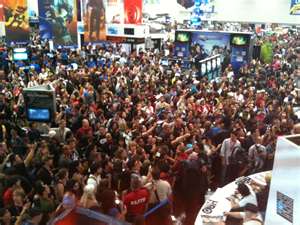Author John Scalzi has opened a new chapter in the ongoing debate about harassment at fan conventions. Scalzi is a successful science fiction author, and until very recently he was the president of Science Fiction and Fantasy Writers of America. A week after his tenure as president ended, Scalzi announced what he refers to as his new hard requirement for any convention that wants him as a panelist, participant, or guest of honor. The convention must have a very clear and readily accessible anti-harassment policy. Said policies must include clear guidelines about what is unacceptable behavior, and where attendees can go for help in those circumstances. The policies have to be made available in places such as the program book or the convention website.
This comes in parallel to another recent incident involving Penny Arcade. You can find more specifics here, but in short Penny Arcade co-founder Mike Krahulik got into a fight on twitter over comments involving transgender issues. The commentary got heated and Krahulik made what many people felt were transphobic comments. Taken on its own it is bad enough, but there was also the specter of the “Dickwolf” controversy from a couple of years ago, which had many people starting to look at Penny Arcade and it’s convention PAX as a hostile environment. The irony here is that PAX has one of the strongest anti-harassment policies of any convention out there. Immediately people started distancing themselves from Penny Arcade, including one game company canceling their booth at the event.
During the Dickwolf issue Krahulik stuck to his guns, which turned a lot of people off. In the time between then and now, he and the people around him clearly learned from the experience. The two days after the transgender argument saw Krahulik issue multiple apologies, admit he has an issue of getting hostile when feeling threatened, and a vow to try to work on these issues. He also made a $20,000 donation to the Trevor Project as a sign of contrition. He also acknowledged that his behavior was damaging to the Penny Arcade brand.
So with these events having just happened, we are once again having the conversation of how welcoming the fan community environment is to people. The positive in both these cases is that there is clear recognition that there are issues and that they need to be dealt with. I also feel they show that progress is being made.
In the Penny Arcade case, in the past this issue would have just festered, but now there is acknowledgement that there was a problem and an actual apology. It is a step in the right direction.
In the case of John Scalzi, you have a prominent author using the cred he has built up over the years to attempt to influence positive change. As of this writing, several 100 people, myself included, have co-signed his pledge.
This does put me in a slightly awkward position, of course. My local convention, Norwescon, is one of the conventions currently lacking in such a policy. However, they aren’t ignoring it. They had a discussion forum that I participated in at this year’s convention about adopting such a policy. Also someone connected with the convention posted in Scalzi’s comment section that they are forwarding the discussion to the convention committee for additional consideration. It is all about getting these important conversations started.
Emerald City Comicon is also in the same boat. I expect they will be addressing this soon as well. At least I hope they do.
It is worth noting that San Diego Comic Con also lacks an adequately published policy. They have one apparently, but it is not where you could find it.
If you are looking for a good listing of which conventions do or do not have policies in place, the site Girl Wonder is compiling a database that can be found here.
While it is clear that we still have a lot of work to do, I feel hopeful that we are seeing positive change, and that geek culture is coming around in regards to how it treats everyone.
I’ll be keeping an eye on all of this and I am sure we will be talking about it again in the future.



